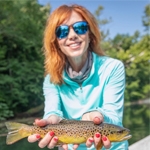A First Timer’s Guide: South Holston River Fly Fishing
By Anietra Hamper
Aug 23, 2022
A first timer’s guide to South Holston River fly fishing with tips for where to go, what to know and how to take that first step.
Fly fishing on the South Holston River in northeastern Tennessee means angling on one of the best naturally producing wild brown trout fisheries in the United States. This river system has a unique combination of elevation, consistent cold water flowing from the South Holston Dam and a natural fishery with concentrated populations of trout making it a great location for both novice and advanced fly-fishing anglers.
Some of the best South Holston River fly fishing is on a 15-mile stretch of the river from the South Holston Dam in Bristol to Boone Lake in Bluff City. There are an estimated 8,500 fish per mile with 85 percent of the populations being wild brown trout.
This stretch of river, between the South Holston Lake and the Holston River, flows for 136-miles from Kingsport, Tennessee to Knoxville. The large numbers of fish in the South Holston River make this a great year-round waterway for fly fishing beginners namely because your chances of catching are greater giving you ample opportunity to practice and perfect your skills.
All you need to get started is a desire to learn and a valid Tennessee fishing license. Here are some of the fly-fishing basics to get you started on the South Holston River.
Hiring a Guide
It is best for first timers to hire an experienced guide who can provide the fly-fishing gear you will need for the day and teach you proper techniques for fishing on this river. Part of your outing will be spent learning the basics about gear, casting techniques, the environment on the water and how to find, fish for and handle the trout. A guide service will be able to pick you up and transport you to the water. They will provide all the basic fly-fishing gear and many guides offer packages with lunch included. All you need is a fishing license, sunscreen, and polarized sunglasses.
Fly Fishing Techniques
Understanding and executing fly-fishing techniques is sometimes a barrier for first timers to this kind of angling. It is more technical than other forms of fishing, but fly-fishing comes with its own rewards. You will learn about the local environment by selecting flies that that mimic the bugs that the fish are naturally eating at any given time of the year. Fly-fishing can be done from a drifting boat or by wading in the water.
For a leg up on fly-fishing techniques you can practice before you go. Places like Orvis offer free fly-fishing classes and you can find many free resources online. Part of the joy of fishing and fly-fishing is being in nature so the more you know before you go, the more you will get out of the experience.
Reading the Water
Knowing how to read the water on the South Holston River is important not just for catching fish but for safety. The dam above the river has controlled releases that change regularly so it is essential to know when those releases are happening especially if you plan on wading or going on your own.
Reading the water is also important for your success in catching fish. You will look for trout in the riffles, near structure and near depth changes. You have an advantage on this river because given the dense population of fish, nearly every spot where you think there might be a fish, there probably is one.
Regulations
It is important to understand the regulations for the species and waterways that you are fishing no matter where you do it. Most anglers and outfitters on the South Holston River practice catch and release, but Tennessee regulations have a protected slot trout of 16-22 inches for brown and rainbow trout.









